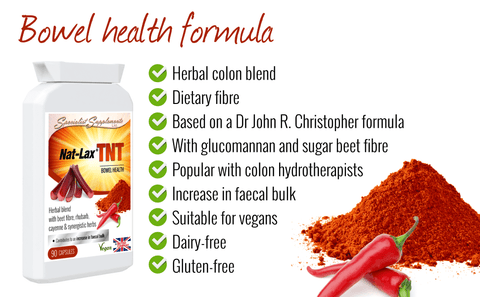
天然草本腸道健康配方
由美國草本專家Dr John R. Christopher研製,配方包括甜菜纖維、大黃、葡甘聚糖(蒟蒻)、辣椒、蒲公英、蘆薈葉、生薑、蕁麻葉、伏牛花樹皮及陳皮大蒜。
A herbal colon care product with a combination of sugar beet fibre (for support of faecal bulk), rhubarb, glucomannan, cayenne, dandelion root, aloe vera leaf, ginger root, nettle leaf, barberry and black aged garlic.


More information:
Nat-Lax TNT contains a unique blend of herbal ingredients:
Rhubarb:
Rhubarb is a herbaceous perennial growing from short, thick rhizomes. It produces large leaves, long fleshy edible stalks and small flowers. In culinary use, fresh raw leaf stalks (petioles) are crisp (similar to celery) with a strong, tart taste.
Glucomannan:
Glucomannan is a water-soluble polysaccharide that is classed as a form of dietary fibre and is usually derived from the konjac root. It can absorb up to 50 times its own weight in water.
Cayenne:
Fiercely hot and pungent, cayenne, also known as cayenne pepper, is one of the most widely used spice ingredients for culinary purposes. Cayenne fruits are slender, elongated pods derived from the capsicum family plant (a cultivar of Capsicum annuum related to bell peppers, jalapeños, paprika, and others). Cayenne is a source of capsaicin.
Sugar beet fibre:
Sugar beet, cultivated Beta vulgaris, is a plant whose root contains a high concentration of sucrose (as its name suggests). It is grown commercially for sugar production.
Sugar beets are related to other B. vulgaris cultivars, such as beetroot and chard. They consist of approximately 75% water, 20% sugar and 5% cell walls. After the sugar is extracted, remaining cell wall material - the sugar beet pulp - is used to produce the sugar beet fibre.
This source of dietary fibre contains both soluble and insoluble fibres. The main fibre types in sugar beet fibre are insoluble hemicellulose (22-32 %) and soluble pectin (22-29 %), but also smaller amounts of cellulose and lignin. It has a water-holding capacity of 3-4 times its own weight.
Compared to many conventional natural sources of dietary fibre, such as cereal products and fruits, sugar beet fibre has the following advantages:
- It has a higher content of dietary fibre, with an ideal balance of 2/3 insoluble fibre.
- It contains no phytic acid (cereal products, such as bran and flour, contain phytic acid which forms strong chemical complexes with iron and zinc and can consequently impair or reduce the natural absorption of these essential minerals in the human body).
- It is naturally free from gluten, which means it is an excellent dietary fibre source for people suffering from gluten intolerance.
Sugar beet fibre contributes to an increase in faecal bulk in two ways: the insoluble components of the fibre increase faecal bulk by absorbing water in the large intestine, while the soluble components are fermented by bacteria in the large intestine leading to an increase in bacterial mass. Click here for EFSA scientific opinion.
Dandelion root:
Dandelion is a flowering plant that belongs to the family Asteraceae. There are around 30 species of dandelion that can be found all over the world and it is usually considered to be a weed. Belgium is one of the only countries that cultivates and makes use of it in large quantities. Despite its misleading reputation, dandelion is actually widely used for human consumption, including in foods, as an ingredient of beverages and in the production of herbal supplements.
Aloe vera leaf:
Aloe vera is a succulent plant and part of the lily family (Liliaceae), the same family that garlic and onions belong to. Different parts of the plant are used for different purposes and aloe vera has both internal and external applications.
Ginger root:
Ginger (Zingiber officinale), is a rhizome - a thick underground stem that sprouts roots and shoots. This "hot" spice is native to warmer parts of Asia, such as China, Japan, and India, but is now also grown in parts of South American and Africa.
Nettle leaf:
Urtica dioica, often called common nettle, stinging nettle (although not all plants of this species sting) or nettle leaf, is a herbaceous perennial flowering plant in the family Urticaceae. It is native to Europe, Asia, northern Africa, and western North America and has been introduced elsewhere.
Barberry:
Barberry, also referred to as mountain grape, pepperidge, berberry and the common grape, is a species of deciduous and evergreen shrub native to the temperate and sub-tropical regions of Europe, Asia, Africa, North America and South America.
Black aged garlic:
Garlic (Allium sativum) is a bulbous plant, which is widely used around the world for its pungent flavour, as a seasoning or condiment and as an ingredient in herbal supplements. It contains sulphur compounds. Black garlic originated in Korea and is raw garlic that has been fermented.
